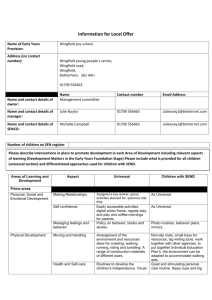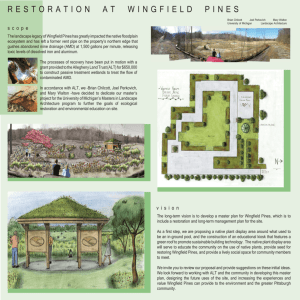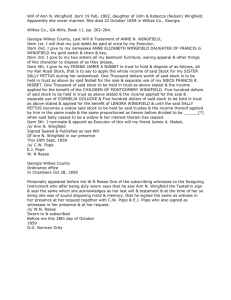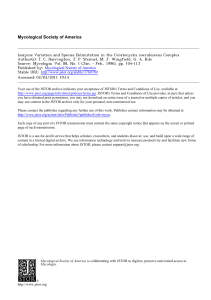Mycological Society of America
advertisement
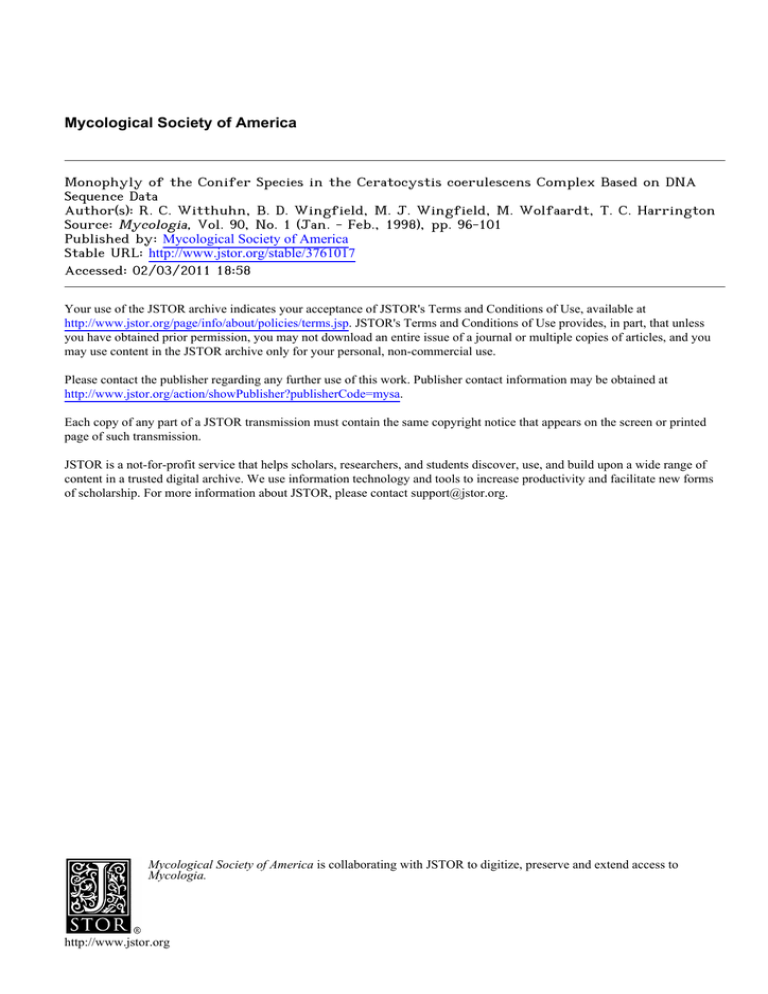
Mycological Society of America Monophyly of the Conifer Species in the Ceratocystis coerulescens Complex Based on DNA Sequence Data Author(s): R. C. Witthuhn, B. D. Wingfield, M. J. Wingfield, M. Wolfaardt, T. C. Harrington Source: Mycologia, Vol. 90, No. 1 (Jan. - Feb., 1998), pp. 96-101 Published by: Mycological Society of America Stable URL: http://www.jstor.org/stable/3761017 . Accessed: 02/03/2011 18:58 Your use of the JSTOR archive indicates your acceptance of JSTOR's Terms and Conditions of Use, available at . http://www.jstor.org/page/info/about/policies/terms.jsp. JSTOR's Terms and Conditions of Use provides, in part, that unless you have obtained prior permission, you may not download an entire issue of a journal or multiple copies of articles, and you may use content in the JSTOR archive only for your personal, non-commercial use. Please contact the publisher regarding any further use of this work. Publisher contact information may be obtained at . http://www.jstor.org/action/showPublisher?publisherCode=mysa. . Each copy of any part of a JSTOR transmission must contain the same copyright notice that appears on the screen or printed page of such transmission. JSTOR is a not-for-profit service that helps scholars, researchers, and students discover, use, and build upon a wide range of content in a trusted digital archive. We use information technology and tools to increase productivity and facilitate new forms of scholarship. For more information about JSTOR, please contact support@jstor.org. Mycological Society of America is collaborating with JSTOR to digitize, preserve and extend access to Mycologia. http://www.jstor.org Mycologia, 90(1), 1998, pp. 96-101. ? 1998 by The New York Botanical Garden, Bronx, NY 10458-5126 Monophyly of the conifer species in the Ceratocystiscoerulescens complex based on DNA sequence data R. C. Witthuhn B. D. Wingfield1 M. J. Wingfield M. Wolfaardt INTRODUCTION Ceratocystis sensu stricto Ellis & Halsted includes many economically important species, which are pathogens on a wide variety of plants, including forest and fruit trees, sweet potatoes, rubber and sugar cane (Kile, 1993). Most Ceratocystisspecies occur on angiosperms, but Ceratocystis coerulescens (Munch) Bakshi, first described from Germany (Munch, 1907), is the cause of sapstain on spruce and pine. Based on isozyme analysis Harrington et al. (1996) demonstrated five morphologically distinct species previously known as C. coerulescens.The C. coerulescens complex thus includes species A, B and C from logs or wounds on Picea or Pinus (Harrington et al., 1996) and two newly recognized species, C. rufipenni Wingfield, Harrington and Solheim and C. douglasii (Davidson) Wingfield and Harrington (Wingfield et al., 1997). Ceratocystisdouglasii causes a stain in wood of Douglas-fir (Pseudotsugae menziesii) (Davidson, 1953; Wingfield et al., 1997), and C. rufipenni occurs on spruce attacked by the bark beetle Dendroctonus rufipennis (Davidson, 1955; Wingfield et al., 1997). Ceratocystislaricicola Redfern and Minter and C. polonica (Siemaszko) Moreau also occur on conifers and are morphologically similar to C. coerulescensbut have smaller and more ellipsoid ascospores (Harrington et al., 1996). Ceratocystispolonica is associated with the bark beetle Ips typographuson spruce in Europe (Siemaszko, 1938; Christiansen and Solheim, 1990) and Japan (Yamaoka et al., 1997). Harrington et al. (1996) found C. laricicola, which occurs on larch infested with the bark beetle Ips cembraein Europe (Redfern et al., 1987) and Japan (Visser et al., 1995), to be morphologically indistinguishable from C. polonica. Comparisons of these species using DNA sequence data also suggest that they may be synonyms (Visser et al., 1995), although they differ at a single isozyme locus (Harrington et al., 1996) and are not sexually compatible (Harrington and McNew, unpublished). Ceratocystisvirescens (Davidson) Moreau, described by Davidson (1944) from hardwood lumber, has been considered a synonym of C. coerulescens(Hunt, 1956; Upadhyay, 1981). More recent studies have shown that it is restricted to hardwood hosts, as a pathogen on maple or as a saprophyte, and is morphologically distinct from C. coerulescens(Harrington et al., 1996; and Biochemistry, PO Box Departmentof Microbiology 339, Universityof theFreeState,Bloemfontein,9300, SouthAfrica T. C. Harrington Departmentof Plant Pathology,351 BesseyHall, Iowa StateUniversity, Ames,Iowa, 50011, USA Abstract. Ceratocystissensu stricto includes numerous species of insect-vectored, wood-staining and plant pathogenic fungi. Among these, Ceratocystiscoerulescensis a well-known cause of blue-stain in spruce and pine. Previous investigations, using morphological characteristics and isozyme comparisons, have shown that C. coerulescensencompasses at least five morphological types. The aim of this study was thus to compare isolates of C. coerulescenssensu lato and morphologically similar species, including C. laricicola, C. polonica, C. virescens, C. eucalypti, Chalara australis and Ch. neocaledoniae, on the basis of DNA sequence data. Using the polymerase chain reaction (PCR), a 600 base pair fragment within the ribosomal DNA operon was amplified, and the PCR products were sequenced. The analyzed sequence included the 5.8S rRNA gene and the internal transcribed spacers (ITS) 1 and 2. Relationships were determined by parsimony analysis. Using C. fimbriata as the outgroup taxon, the five morphological types previously known as C. coerulescensand the two other taxa from conifers formed a strongly-supported monophyletic group that includes all the Ceratocystis species occurring primarily on conifers. The species from hardwood trees, C. eucalypti, Ch. australis and Ch. neocaledoniae, also formed a monophyletic group, sister to the conifer group. The fourth species from hardwoods, C. virescens, formed a group basal to the two sister groups. Key Words: ITS sequence, phylogeny, ribosomal DNA Accepted for publication July 21, 1997 'Corresponding author, email: brenda@wwg3.uovs.ac.za 96 97 WITTHUHN ET AL.: C. COERULESCENS COMPLEX TABLE I. Isolatesof Ceratocystis used for DNA sequencing, their origins and GenBankAccessionNumbersof ITS sequence of DNA Isolate numbera Host Origin GenBank AccessionNumber C490, CMW1323 C313, CBS140.37 C50, CMW0451 Species C. coerulescens sp. A C. coerulescens sp. B C. coerulescens sp. C Pinus sp. Picea abies Picea engelmannii England Germany USA U75614 U75615 U75616 C662 C666 C609 C610 C612 CMW1016 C708, CMW0672, C. coerulescenssp. C C. coerulescenssp. C C. rufipenni C. rufipenni C. rufipenni C. laricola C. polonica Picea abies Picea abies Picea engelmannii/D. rufipennisb Picea engelmannii/D. rufipennisb Picea engelmannii/D. rufipennisb Larix decidua/I. cembraeb Picea abies/I. typographusb Norway Norway Canada Canada Canada Scotland Norway U75617 U75618 U75619 U75620 U75621 U75622 U75623 C74, CMW0460 C251 C. virescens C. virescens Quercussp. Acer sp. USA USA U75624 U75625 C69 C. virescens Fagus americanum USA Sequence = U75625 C203, ATCC11066 C. virescens Liriodendron tulipifera USA Sequence = C324, CBS142.53 C. douglasii Pseudotsuga menziesii USA U75626 C639 C694, CBS149.83 C. eucalypti Chalaraneocaledoniae Eucalyptussieberi Coffearobusta Australia New Caledonia U75627 U75628 C619 C854 Chalara australis C. fimbriata Nothofagus cunninghamii Ipomoea batatas Australia USA U75629 AF007749 CBS228.83 U75625 CMW-Culture collection of M. J. Wingfield. C-Culture collection of T. C. Harrington. CBS-Centraal Bureau voor Kile and Walker, 1987). Ceratocystiseucalypti Yuan and Kile is morphologically similar to C. virescensand colonizes wounds in Eucalyptus in Australia (Kile et al., 1996). Two Chalara species, namely Ch. neocaledoniae Kiffer and Delon and Ch. australis Walker and Kile, have no known teleomorphs, but their anamorphs are similar in morphology to the anamorphs of C. virescens and C. eucalypti (Harrington et al., 1996) and are thus included in the present study of the C. coerulescenscomplex. Both these Chalara species cause diseases in hardwoods that are similar to sap streak of maple caused by C. virescens (Kile, 1993). Chalara australis occurs in Australia on Nothofagus cunninghamii and Ch. neocaledoniae was described from coffee and guava in New Caledonia (Kile et al., 1996). Sequence data from the ribosomal RNA genes has successfully been used in determining the phylogenetic relationships among species of Ceratocystis (Hausner et al., 1993; Wingfield et al., 1994; Visser et al., 1995; Wingfield et al., 1996). High variability in DNA sequence exists among these species in the internal transcribed spacer (ITS) regions of the ribosomal RNA genes (Visser et al., 1995; Wingfield et al., 1996). The aim of this study was, therefore, to compare species of the Ceratocystiscoerulescenscomplex using the DNA sequence from the variable ITS regions in the ribosomal RNA operon. a Schimmelcultures,Baarn,Netherlands.ATCC-AmericanType CultureCollection. b Barkbeetle associates,where known, are in the genera Ips and Dendroctonus. ANDMETHODS MATERIALS All isolates (TABLEI) were grown on malt extract agar (20 g/L ME and 20 g/L agar) in Petri dishes at room temperature for 10 d. Template DNA for amplification was obtained by scraping the mycelium with a pipette tip (Harrington and Wingfield, 1995). Amplifications were performed using the primers ITS1 and ITS4 (White et al., 1990) or ITS1F (Gardes and Bruns, 1993) and ITS4. The amplified fragments include the 3' end of the small subunit (SSU) rRNA gene, the 5.8S rRNA gene, part of the large subunit (LSU) rRNA gene and the internal transcribed spacer (ITS) regions 1 and 2. The PCR reaction mixture included 2.5 units of Taq polymerase (Boehringer Mannheim, Mannheim, Germany), the buffer supplied with the enzyme, 250 JLMdNTPs, 6.25 mM MgCl2 and 0.5 FpMof each primer. Initial denaturation was performed at 96 C for 60 s, followed by 35 cycles of primer annealing at 55 C for 30 s, chain elongation at 72 C for 60 s and denaturation at 92 C MYCOLOGIA 98 C. fimbriata Ch. australis (Nothofagus spp.) C. eucalypti (Eucalyptus spp.) 3 g(Coffea spp.) C. douglasii (Pseudotsuga spp.) 2 m C. coerulescens sp. A (Pinus spp.) C. coerulescens sp. B (Picea spp.) IC. laricicola (Larix spp.) C. polonica (Picea spp.) coerulescens sp. C (C50) coerulescens sp. C (C662) coerulescens sp. C (C666) _ C. rufipenni(C609) C. rufipenni (C610) IC. rufipenni(C612) I (Picea spp.) FIG. 1. One of the two most parsimonious trees produced from analysis of the DNA sequence of part of the ribosomal RNA operon (565 bp in size) using PAUP 3.1.1. Tree length = 124. The number of base substitutions are indicated above the branches and the bootstrap percentages (100 bootstrap replicates) and decay index (100 replicates) are indicated below the branches.Host species are indicatedin brackets. for 60 s. Final chain elongation took place at 72 C for 5 min. The PCR products were separated on 1.5% agarose gels, stained with ethidium bromide and visualized using UV light. The 600 base pair PCR fragments were purified using Wizard PCR Mini-Preps (Promega Corporation, USA) or Microcon Microconcentrators (Amicon, Inc., USA). Both strands of the PCR products were sequenced using the finol DNA Sequencing Kit (Promega Corporation., USA). Seven of the isolates were sequenced using the ABI PRISM 377 DNA sequencer and ABI PRISM 310 Genetic Analyzer (Perkin-Elmer, USA) at the DNA Sequencing Facility at Iowa State University. The primers ITS1, ITS1F, ITS2, ITS3 and ITS4 were used in the sequencing reactions. The DNA sequence data were deposited in GenBank (TABLEI). The nucleotide sequences were manually aligned, then analyzed using PAUP (Phylogenetic Analysis Using Parsimony) 3.1.1 (Swofford, 1993). The ITS sequence of CeratocystisfimbriataEllis & Halsted, isolated from sweet potatoes, was used as an outgroup. Confidence intervals of the branch points were determined using the bootstrap technique (Felsenstein, 1985) and decay indexes (AUTODECAY 2.9.4., a computer program developed by Torsten and Eriksson in 1996). Sequence alignments and cultures are available from the corresponding author. RESULTS The PCR amplifications from living fungal mycelium of isolates studied consistently produced amplification products of approximately 600 bp, and the DNA sequences of the species in the C. coerulescenscomplex were found to be similar. It was possible to align the data manually by inserting gaps in the sequence data. With C. fimbriata as the outgroup taxon, two most parsimonious trees of 124 steps were produced from the aligned 565 bp sequence data, including ITS 1 and 2 and the 5.8S gene, using the Heuristic search option of PAUP (FIG. 1) (CI=0.887, HI=0.113, RI=0.899, RC=0.797). Gaps were treated as missing data. The two trees differed only in the relationship between C. coerulescensspecies A and B and C. douglasii. One tree (FIG. 1) grouped C. coerulescens species A and B, while the second tree grouped C. coerulescensspecies B and C. douglasii. The same topology was obtained when midpoint rooting was used. All the species associated with conifers, that is, C. coerulescensspp. A, B and C, C. douglasii, C. laricicola, WITTHUHN ET AL.: C. COERULESCENS COMPLEX C. polonica and C. rufipenni, formed a single clade, supported by a bootstrap value of 98% and a decay index of d3. Among the conifer species, three isolates of C. rufipenni grouped closely together into one well supported subclade (91%, d3). A second distinctive subclade was formed by the three isolates of C. coerulescens species C (71%, dl). C. laricicola and C. polonica had identical sequences and grouped together (85%, dl), forming a subclade sister to the clade formed by C. coerulescenssp. A and sp. B and C. douglasii (62%, dl). The three Australasian species from hardwoods, C. eucalypti, Ch. neocaledoniae and Ch. australis, grouped in a clade sister to the conifer clade (59%, dl). The fourth species from hardwoods, namely C. virescens, represented by four isolates with identical sequence, was basal to the conifer and Australasian subgroups (100%, d6). Numerous gaps were created to achieve the alignment and there were regions of ambiguity, particularly in aligning the outgroup with the ingroup. The same tree topology was observed when ten ambiguously aligned regions (157 bases in total) were removed from the data set. Since most of the alignment ambiguity was between the ingroup and the outgroup, C. fimbriata, the data set was realigned and reanalyzed after the removal of the C. fimbriata sequence. C. virescenswas defined as the outgroup and two ambiguously aligned regions (52 bases in total) near the large subunit gene were removed, with the gaps treated as a fifth character (gapmode=newstate). Two parsimonious trees of 90 steps were produced from the aligned 477 bp sequence data (CI=0.811, HI=0.189, RI=0.919, RC=0.776). Both these trees reflected the same topology as found when C. fimbriata was used as an outgroup, with C. coerulescens species A and B grouping together (69%, d3). In the one tree C. coerulescensspecies C was basal to the rest of the conifer species (95%, d3). The conifer subclade (98%, d4), the Australasian subclade (92%, d2), as well as the subclade including C. coerulescensspecies A and B, C. douglasii, C. laricicolaand C. polonica (99%, d5) were better supported after the removal of C. fimbriata than in the analysis with C. fimbriata as the outgroup taxon. DISCUSSION The phylogenetic analyses show that species of Ceratocystis from conifers form a distinct clade, suggesting that these species are monophyletic. This is despite the fact that they differ somewhat in their morphology and more noticeably in their ecology, except that they all occur on conifers in the family Pinaceae. In fact these are the only Ceratocystisspecies that commonly occur on conifers. It appears that the adaptation to conifers is a derived character in Ceratocystis,which otherwise 99 occur on dicots and monocots. This change in host range may have evolved only once in the genus. In this study it was possible to determine a phylogenetic relatedness of species in the C. coerulescens complex based on DNA sequence data from the variable region in the ribosomal RNA operon. The results confirmed the recent delineation of species in this complex based on morphology and isozyme analyses (Harrington et al., 1996). There was less variation than expected in the DNA sequence data of the ITS regions among species in the C. coerulescenscomplex. Little or no variation exists between these species in the highly conserved large subunit rRNA gene (authors, unpublished), which indicates close relationships in the complex as a whole. Ceratocystiscoerulescenshas been recognized as a causal agent of blue-staining of conifers in Europe and in North America (Kile, 1993). In the years subsequent to its description, this species had become a repository for many wound and lumber colonizing fungi that generally resemble the fungus originally described by Munch (1907). Species such as C. virescens were reduced to synonymy with C. coerulescens (Hunt, 1956; Upadhyay, 1981), and the taxa recently described as C. douglasii and C. rufipenni (Wingfield et al., 1997) were treated under the name C. coerulescens. In a recent study based on isozyme analyses, Harrington et al. (1996) showed that these species and three additional species, designated C. coerulescens species A, B and C, represent distinct taxa. The sequence data support these delimitations. Our results indicate that C. coerulescenssp. A and C. coerulescenssp. B are closely related but distinct, and these species form a clade with C. douglasii. C. douglasii was originally described as C. coerulescensf. douglasiiby Davidson (1953), who noted differences in the anamorphs of C. douglasii and C. coerulescens.He also noted that the former causes stain in Douglas-fir rather than spruce and pine. The isolates of C. laricicolaand C. polonica had identical ITS sequences. Harrington et al. (1996) and Visser et al. (1995) showed that these fungi are very similar and may be conspecific. These bark beetle associates differ from the other conifer species in the C. coerulescenscomplex in ascospore morphology (Harrington et al., 1996) but form a weaklysupported clade with C. coerulescenssp. A, sp. B and C. douglasii. Isozyme analyses also showed similarity between C. laricicolaand C. polonica and C. coerulescens species A and B (Harrington et al., 1996). Included in the conifer clade were C. coerulescens sp. C and C. rufipenni, which is associated with the bark beetle Dendroctonus rufipennis, which attacks spruce in North America. The three isolates of C. coerulescensspecies C, which have perithecial necks shorter than those of C. coerulescenssp. A but other- MYCOLOGIA 100 wise are morphologically similar (Harrington et al., 1996), form a distinct clade separate from the other conifer species. Relationships among C. rufipenni, C. coerulescenssp. C and the other conifer species are not well resolved. Ceratocystis eucalypti appears to be very closely re- lated to Ch. australis and Ch. neocaledoniae. These fungi are common to Australasia, and their apparent relatedness is not surprising. It has also been shown that Ch. australis is partially interfertile with MAT-1 strains of C. eucalypti (Kile et al., 1996). C. virescens, also on hardwoods, has a morphology similar to that of C. eucalypti (except the latter has much larger ascospores) and was found to be basal to the Australasian hardwood species and to the conifer species. The phylogenetic relationships as determined here differ somewhat from the distance analysis derived from isozyme data (Harrington et al., 1996). Our phylogenetic approach shows taxa on conifers to be monophyletic, possibly evolving from a hardwood ancestor. The hardwood species, Ch. neocaledoniae, Ch. australis and C. eucalypti,grouped more closely with each other based on the DNA sequence data than on the isozyme markers. Also, C. douglasii differed substantiallyfrom all other species in the complex based on isozymes but was near C. coerulescenssp. A and sp. B based on the ITS sequence data. In both analyses, C. laricicolaand C. polonica were closer to C. coerulescens sp. A and sp. B than to C. coerulescens sp. C and C. rufipenni. In this study we have shown that it is possible to distinguish taxa in Ceratocystis based on DNA sequence data from the ribosomal RNA operon. The fact that various species that we have considered have been compared using other techniques with very similar results gives us substantial confidence in this approach. The data pointed to the importance of host range in the evolution of Ceratocystisspecies. We believe that there is considerable opportunity to compare other species of Ceratocystisand related fungi based on sequence data of the ribosomal RNA operon and expect that this will result in a considerable improvement in our understanding of the relationships of the group. ACKNOWLEDGMENTS We thank the Foundation for Research Development (FRD) and the Members of the Tree Pathology Co-operative Program (TPCP), South Africa, for financial support. CITED LITERATURE Christiansen, E., and H. Solheim. 1990. The bark beetleassociated blue-stain fungus Opiostoma polonicum can kill various spruces and Douglas fir. Eur.J. For Pathol. 20: 436-446. Davidson, R. W. 1944. Two American hardwood species of Endoconidiophoradescribed as new. Mycologia 34: 650662. .1953. Two common lumber staining fungi in the western United States. Mycologia 45: 579-586. . 1955. Wood-staining fungi associated with bark beetles in Engelmann spruce in Colorado. Mycologia 47: 58-67. Felsenstein, J. 1985. Confidence intervals on phylogenies: An approach using the bootstrap. Evolution 39: 783791. Gardes, M., and T. D. Bruns. 1993. ITS primers with enhanced specificity for basidiomycetes-application to the identification of mycorrhizae and rusts. Molec. Ecol. 2: 113-118. Harrington, T. C., J. P. Steimel, M.J. Wingfield, and G. Kile. 1996. Isozyme variation in the Ceratocystiscoerulescens complex. Mycologia 88: 104-113. , and B. D. Wingfield. 1995. A PCR based identification method for species of Armillaria. Mycologia 87: 280-288. Hausner, G., J. Reid, and G. R. Klassen. 1993. On the subdivision of Ceratocystiss.l., based on partial ribosomal DNA sequences. Canad. J. Bot. 71: 52-63. Hunt, J. 1956. Taxonomy of the genus Ceratocystis.Lloydia 19: 1-58. Kile, G. A. 1993. Plant diseases caused by species of Ceratocystissensu strictoand Chalara. Pp. 173-183. In: Ceratocystis and Ophiostoma: Taxonomy, Ecology and Pathogenicity.Eds., M. J. Wingfield, K A. Seifert and J. F. Webber. APS Press, St. Paul, Minnesota. , T. C. Harrington, Z. Q. Yuan, M. J. Dudzinski, and K M. Old. 1996. Ceratocystiseucalypti sp. nov., a vascular stain fungus from eucalypts in Australia. Mycol. Res. 100: 571-579. , and J. Walker. 1987. Chalara australis sp. nov. (Hyphomycetes), a vascular pathogen of Nothofagus cunninghamii (Fagaceae) in Australia and its relationship to other Chalara species. Austral. J. Bot. 35: 1-32. Muinch, E. 1907. Die blaufaule des nadelhoises. Naturwiss. Z. Forst-Landw.5: 531-573. Redfern, D. B., J. T. Stoakley, H. Steele, and M. Minter. 1987. Dieback and death of larch caused by Ceratocystis laricicola sp. nov. following attack by Ips cembrae.P1. Pathol. 36: 467-480. Siemaszko, W. 1938. Zespoly Grybow TowarzyszacychKornikom Polskim. P1. Polonica 7: 1-52. Swofford, D. L. 1993. PAUP PhylogeneticAnalysis using Parsimony Version 3.1.1. Illinois Natural History Survey, Champaign, Illinois. Upadhyay, H. P. 1981. A monograph of Ceratocystis and Ceratocystiopsis. The University of Georgia Press, Athens, Georgia. 176 pp. Visser, C., M. J. Wingfield, B. D. Wingfield, and Y.Yamaoka. 1995. Ophiostomapolonicum is a species of Ceratocystis sensu stricto. Syst. Appl. Microbiol. 18: 403-409. White, T.J., T. Bruns, S. Lee, and J. Taylor. 1990. Amplification and direct sequencing of fungal ribosomal RNA genes for phylogenetics. Pp. 315-322. In: PCR protocols: A guide to methods and applications. Eds., M. A. Innis, WITTHUHN ET AL.: C. COERULESCENS COMPLEX D. H. Gelfand, J. J. Sninsky and T. J. White. Academic Press, San Diego, California. Wingfield, M. J., C. de Beer, C. Visser, and B. D. Wingfield. 1996. A new Ceratocystisspecies defined using morphological and ribosomal DNA sequence comparisons. Syst. Appl. Microbiol. 19: 191-202. , T. C. Harrington, and H. Solheim. 1997. Two new 101 species in the Ceratocystiscoerulescenscomplex from conifers in western North America. Canad. J. Bot. 75: 827-834. Yamaoka, Y, M.J. Wingfield, I. Takahashi, and H. Solheim. 1997. Ophiostomatoid fungi associated with the spruce bark beetle Ips typographusin Japan. Mycol. Res. 101: 1215-1227.
